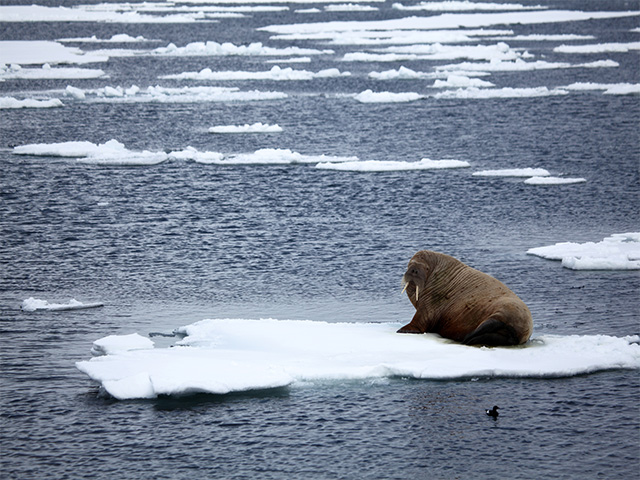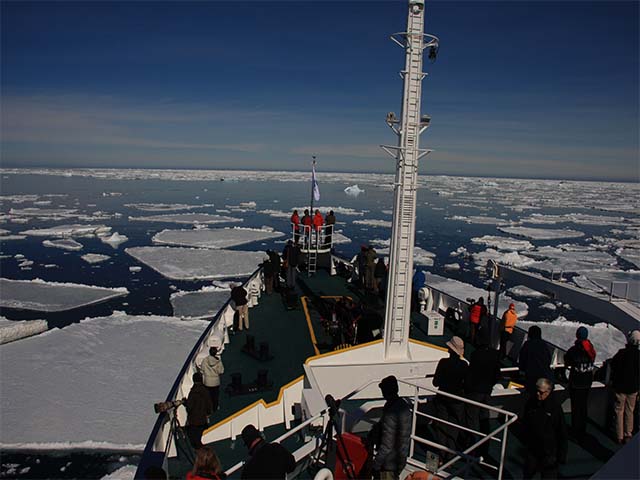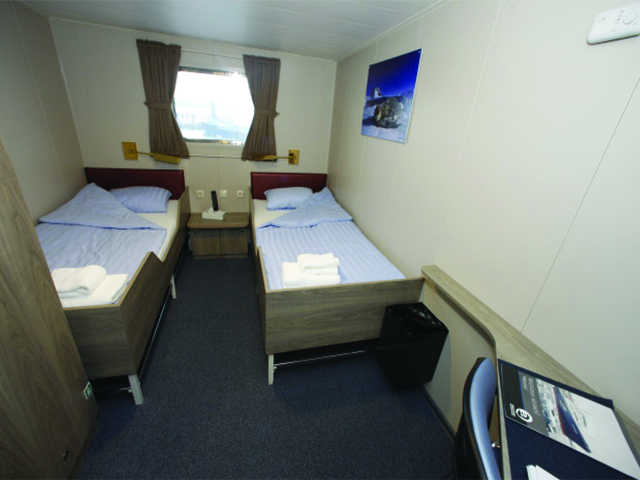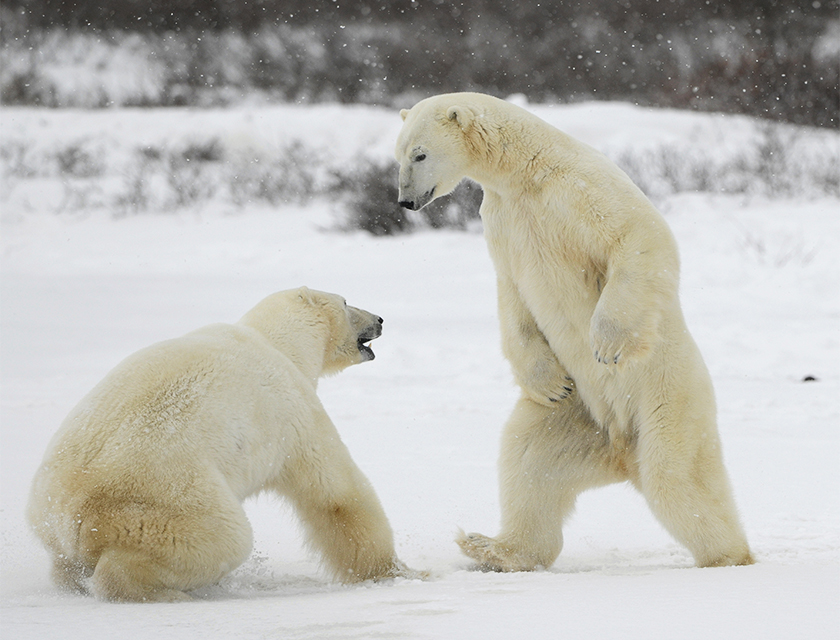- 1Longyearbyen, Norway
Today, we arrive in Longyearbyen, the administrative capital of the Spitsbergen archipelago, of which West Spitsbergen is the largest island. Before embarking on this spectacular journey, you can take a stroll around this former mining town, whose parish church and Polar Museum are well worth a visit. Early evening, the ship will sail out of Isfjorden. For the next twelve days our stay will be aboard the M/v "Plancius", a vessel with 53 passenger cabins and a capacity to accommodate 114 passengers.
Our expeditions in North-East Greenland are planned in August and September. The reason is that access to this wild coast is dependent on the ice conditions. For much of the year the region is locked in by pack-ice, which only by late summer has broken up sufficiently to allow vessels such as ours to reach land.
Spitsbergen is an Arctic archipelago about 650 kilometers (400 miles) north of Norway. The archipelago ranges from Bear Island (74 degree N) to Rossøya (81 degree N). It is by far the largest wilderness area of Europe. It covers an area of about 62,500 square kilometers, which is roughly the size of Ireland. About 60% of the land is glaciated. As Spitsbergen lies far within the Arctic circle, it experiences the midnight sun from April to August. At this time of year the sun is above the horizon for 24 hours a day!
Since 1925, Norway has sovereignty over Spitsbergen according to the international Spitsbergen Treaty. The Norwegian name for the archipelago is Svalbard. The name Spitsbergen was given by the Dutch explorer Willem Barentsz. The meaning of the name Spitsbergen in the Dutch language is "Jagged Peaks" because of the sharp pointed mountains that Barentsz met in the north-west of Spitsbergen. Spitsbergen, which has a population of about 3000 in 4 settlements, is to this day virtually an unspoilt wilderness. Imagine a place the size of Ireland with only about 50 kilometers (30 miles) of road!
Longyearbyen has approximately 2000 inhabitants and happens to be one of the world's northernmost villages. It is a modern village with a wide range of facilities such as a supermarket, tourist shops, several pubs and hotels, a cinema, a swimming pool, a sports hall and a church. Longyearbyen even has its own university, the UNIS, that offers Arctic studies.
Isfjord, with its vast tundra and abundant reindeer population, Longyearbyen and the Russian mining settlement, Barentsburg, gives one a very good opportunity to see Atlantic Puffins, Geese, Skuas, Svalbard Reindeers, Arctic Foxes and Belugas.
Meals: DinnerAccommodation : M/v “Plancius” - 2Longyearbyen, Norway to Moffen Island,Norway
We sail into Raudfjord on the north coast of West Spitsbergen, a beautiful fjord with spectacular glaciers. It is home to Ringed and Bearded Seals, seabird colonies and surprisingly rich vegetation. Here, we have a good chance to see Polar Bears, for instance, near Hamilton Glacier, or more towards the head of the fjord. From Raudfjord we continue to Moffen Island on which Walruses haul out.
Meals: Breakfast, Lunch and DinnerAccommodation : M/v “Plancius” - 3Moffen Island,Norway to Greenland
The next two days are spent at sea, where we voyage to Greenland. Enjoy the blue of the sea, catch sight of the edge of East Greenland sea-ice and watch out for Whales and migrating seabirds!
Meals: Breakfast, Lunch, DinnerAccommodation: M/v “Plancius” - 5Greenland
Approaching Greenland, we will attempt to sail through the sea ice into Foster Bugt, making our first landing at Myggebugten. Beyond the old hunters’ hut (in the first half of last century Norwegian trappers hunted here for Polar Bears and Arctic Foxes), there is an extensive tundra populated by Musk Oxen. The small lakes are home to geese.
We sail through Kaiser Franz Joseph Fjord, a magnificent fjord with towering mountains on both sides. Its inner sides are choked with huge icebergs. As an alternative, we can sail through Sofia Sund, which is much narrower. On this route, we can see Musk Oxen from the ship.
The northernmost regions of Greenland, or "Kalaallit Nunaat" ("Land of the People") as it is known in the Greenlandic language, is the largest island in the world. It stretches from 60º to 83º north latitude. Kap Farvel, its southern tip, is located at almost the same latitude as the Shetland Islands in Scotland. The extreme north of Greenland is the northernmost point of land on our planet. Greenland is dominated by the second largest ice-sheet in the world; more than 80% of its surface area is covered by ice reaching a thickness of over 3000 meters (10,000 feet) in the interior. Although huge in size (2,166,000 km²), it is inhabited by less than 60.000 people. Greenland is geographically a part of the North American continent but has additional social and political ties with Europe.
The coastline of Greenland is spectacular. It is heavily indented with numerous fjords, consisting of spectacular high mountains, cliffs at a height of 2000 meters (6500 feet) and innumerable glaciers. The large glaciers produce the huge, cathedral-like icebergs that are abundant in Greenlandic waters. The largest fjord is Scoresby Sund and is more than 300 kilometres (185 miles) long.
Meals: Breakfast,Lunch, DinnerAccommodation: M/v "Plancius" - 6Blomster Bugt,Greenland to Ella Island,Greenland
Today, we will land on shore in Blomster Bugt to see some beautiful geological formations. Arctic Hares are usually seen here, and there is a lake where one can spot Great Northern Divers with their young. In the afternoon, we sail along Teufelschloss and Ella.
Meals: Breakfast,Lunch, DinnerAccommodation: M/v "Plancius” - 7Scoresby Sund,Eastern Greenland to Danmark Ø, Denmark
Today, we reach Scoresby Sund and sail in the morning along the ragged and glaciated Volquart Boons. Scoresby Sund, or Kangertittivaq as it is known in Greenlandic, is the longest fjord in the world spanning over more than 350 kilometers (217 miles) in length. Here we may organize a zodiac cruise, (a cruise where zodiacs, or small inflatable boats that have a capacity of around ten to eleven passengers, are used), along one of the glacier fronts of this coast. Our first landing will be at near Maane Glacier.
Later, we reach Danmark, where we find the remains of an Inuit settlement abandoned around 200 years ago. The circular ‘tent rings’ of stones indicate the summer houses, while the winter houses can be seen closer to a small cape. The sites are excellently preserved, allowing entrances and bear-proof meat caches to be identified. There are also grave sites that may be visited here. In the evening, we continue our journey and sail through the beautiful fjords to the west, choked with icebergs.
Meals: Breakfast,Lunch, DinnerAccommodation: M/v "Plancius” - 8Cape Hofmann Halvø, Greenland to Scoresby Land, Greenland
Day nine finds us ashore at Cape Hofmann Halvø, a reliable spot for viewing Musk Oxen. We may also spot Rock Ptarmigans, and Great Northern Divers here. The landscape here is particularly beautiful, especially during autumn when the dwarf willow and dwarf birch change color. Don’t miss the exceptional beauty of the Arctic blueberry and crowberry that add their vibrant touch to the color studded vegetation! While you admire the colors, try and get a taste of the berries too!
In the evening, we sail through the fjord towards Scoresby Land, enjoying the contrast between the warm autumnal colors of the vegetation on shore, against huge dark mountains, and the cold blue of the icebergs.
Meals: Breakfast,Lunch, DinnerAccommodation: M/v "Plancius” - 10Scoresby Land, Greenland
In the morning on day ten, we encounter huge icebergs, some over 100 meters high and more than a kilometer in length, in Northwest fjord at Scoresby Land. Most of the icebergs are grounded, as the fjord is only about 400 meters deep here. We land near Sydkap to view the remains of winter houses built by Thule people. As many as 20 people lived in these tiny houses, hunting Greenland Whales and using their vertebrae to build the houses. We may also land at Gurreholm on Jameson Land. The landscape here is gently undulating.
Meals: Breakfast, Lunch & DinnerAccommodation: M/v "Plancius” - 11Ittoqqortoormiit, Greenland
On day eleven, in the morning, we land at Illoqqortoormiut, the biggest settlement in the Scoresby Sund with about 500 inhabitants. At the post office you can buy stamps for your postcards, or just wander around to see the sledge dogs and the drying skins of Seal, Musk Ox and Polar Bear. After dinner, we sail south passing the amazing landscape of the Blosseville Coast.
Meals: Breakfast, Lunch and DinnerAccommodation: M/v "Plancius” - 12Iceland
Day twelve is spent entirely at sea. Here’s your chance to catch sight of large Whales and seabird migration and, don’t miss the Aurora Borealis (Northern Lights) at night time!
Iceland is situated in the middle of the North Atlantic Ocean, about 800 kilometers north of Scotland and only 280 kilometers from Greenland. Although the vast majority of Iceland is located below the Arctic Circle, a small island, Grímsey, is situated directly on the Arctic Circle. The island is geologically very young; it was created only 16 to 17 million years ago on the Mid-Atlantic Ridge by the movement of the American and Eurasian tectonic plates. The Mid-Atlantic Ridge is still visible at Þingvellir (Thingvellir). There is a lot of geothermal activity in Iceland, with about 800 hot springs including geysers.
The first people who probably set foot on Iceland were monks from Ireland. They settled in the 8th century. Around 870 A.D., the first Norsemen, settlers from Norway, arrived and drove away the monks. Over the centuries more settlers arrived from Norway. Today, Iceland is a modern, technologically advanced country within 5 hours of the east coast of the United States. It is the ideal place for taking a break and for visiting a European outpost with an exciting, lively, and ancient culture all of its own!!
Meals: Breakfast, Lunch, DinnerAccommodation: M/v "Plancius” - 13Akureyri,Northern Iceland to Reykjavík, Iceland
On the last day of the arctic adventure tour, we arrive in Akureyri and are taken by a chartered bus through North Iceland to our hotels in Reykjavik. This is a 6 hour drive.
This trip offers the following optional activity:
Kayaking
In general we plan to offer at least 4 days for kayaking. Basic kayaking experience is required and physical fitness is essential for this activity. Parallel to all other activities we are planning on offering kayaking excursions during morning and / or afternoon landings. The final decision on those excursions will be met by the Expedition Leader. We will provide kayaks and neoprene wet suits. Kayakers will have to bring their own personal gear. Kayaking is subject to weather and prevailing ice conditions.
Please Note: A typical itinerary to the Arctic and North Atlantic Islands could be as above and should be treated as a guide only, not an exact program. Flexibility is the key to all our cruises and our exact route and program will depend on such factors as weather conditions, wildlife encounters, the experience of the expedition leader and the advice of the vessel's captain and crew.
On Northeast Greenland voyages: Transfer and baggage handling between ship in Akureyri and hotels in Reykjavik by coach (5 hours).
Meals: Breakfast
- Accommodation and meals as indicated in the itinerary
- All shore excursions
- Lectures by naturalists
- Point to point arrival and departure transfers
- Registered Guides
- Rubber boots/Snow shoes
- Sightseeing or activities or safaris as mentioned in the itinerary
- Taxes
- All items of personal nature
- Any increase in taxes, fuel cost and emergency rescue costs
- Domestic airfare or Train fare
- Gratuities and Tips
- International airfare
- Meals and drinks not specified in the itinerary
- Optional activities (if any) and personal expenses
- Souvenirs
- Visas, Vaccination and Insurance
Fitness is vital for this level of activity, as the environment traversed may be remote and challenging. These rugged experiences include long walks, trekking, cycling or rafting in isolated areas through variable weather conditions for up to eight to ten hours a day. These trips are usually 13 to 19 days in duration. Maximum altitude reached will be 4000m and you need to be very fit in order to withstand the weather conditions. Good physical condition is essential and previous hill-walking experience or preparation is advisable.






